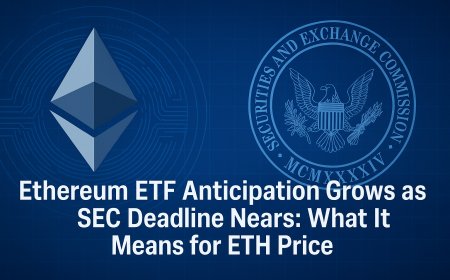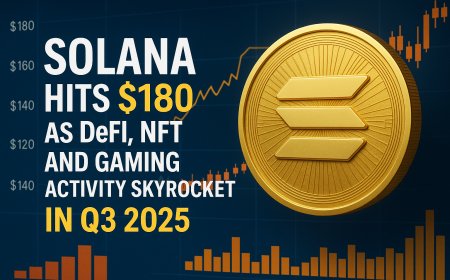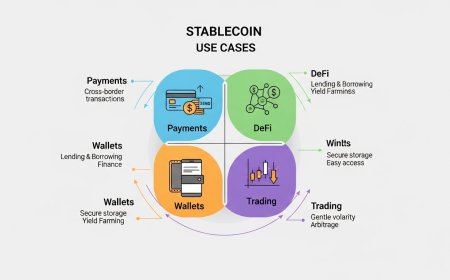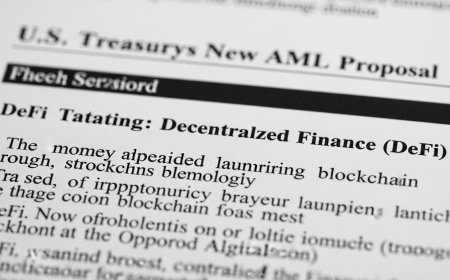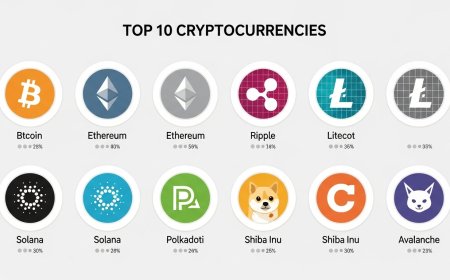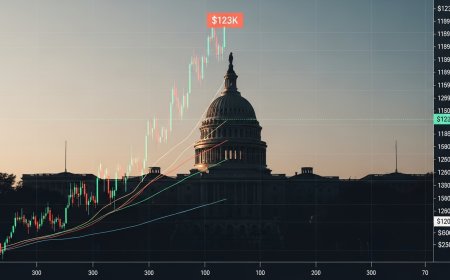Bitcoin ETFs Attracted $14.4B in H1 2025—Tracking the Flow
Discover where $14.4B in Bitcoin ETF inflows went during H1 2025 and why it matters for BTC.
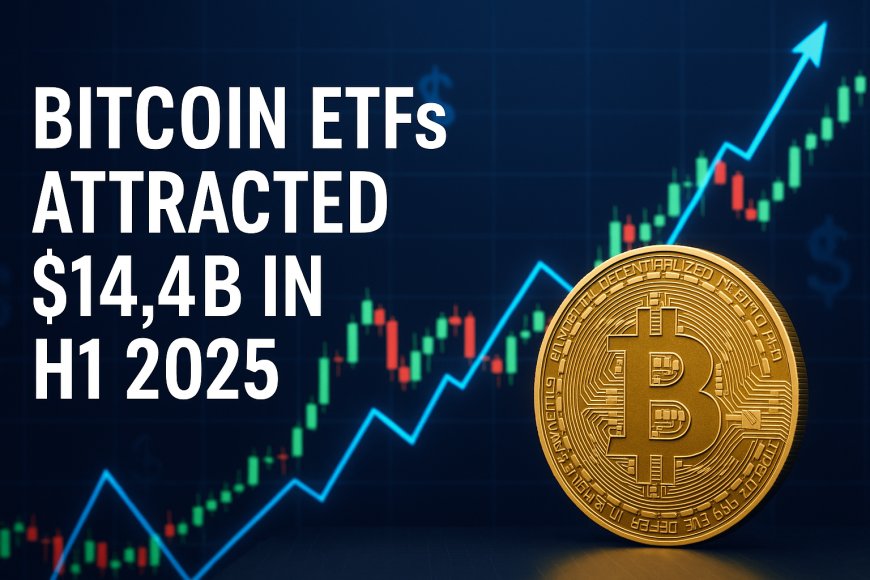
Bitcoin ETFs Attracted $14.4B in H1 2025—Tracking the Flow
Published: July 8, 2025 | Crypto Fortress Market Analysis & ETF Flows
The first half of 2025 has marked a watershed moment for Bitcoin exchange-traded funds (ETFs), with these investment vehicles attracting an unprecedented $14.4 billion in net inflows. This remarkable capital influx represents a significant acceleration in institutional and retail adoption of Bitcoin through regulated investment products, fundamentally reshaping the cryptocurrency investment landscape.
The surge in Bitcoin ETF inflows during H1 2025 has exceeded most analysts' expectations, demonstrating sustained investor appetite for cryptocurrency exposure through traditional financial channels. This trend reflects growing confidence in Bitcoin as a legitimate asset class and the increasing comfort level of both individual and institutional investors with regulated cryptocurrency products.
The $14.4 billion figure represents a substantial increase compared to previous periods, signaling a maturation of the Bitcoin ETF market and its integration into mainstream investment portfolios. This capital flow has important implications for Bitcoin's price dynamics, market structure, and the broader cryptocurrency ecosystem.
Breaking Down the $14.4 Billion Inflow
The massive capital influx into Bitcoin ETFs during the first half of 2025 tells a complex story of investor behavior, market dynamics, and the evolving cryptocurrency investment landscape.
Monthly Distribution and Trends
The $14.4 billion in net inflows was not evenly distributed across the six-month period, with distinct patterns emerging that reflect both market conditions and investor sentiment. January 2025 saw the strongest month with $3.2 billion in inflows, driven largely by institutional investors implementing new cryptocurrency allocation strategies at the beginning of the fiscal year.
February and March experienced more moderate inflows of $1.8 billion and $2.1 billion respectively, as markets digested the initial enthusiasm and price volatility. The spring months of April and May showed renewed acceleration, with $2.9 billion and $2.6 billion in inflows, coinciding with improved macroeconomic conditions and increased corporate adoption announcements.
June concluded the period with $1.8 billion in inflows, demonstrating sustained but more measured investor interest as Bitcoin's price stabilized around key technical levels. This distribution pattern suggests that while initial enthusiasm was high, investors have maintained consistent interest in Bitcoin ETF exposure throughout the period.
Leading ETF Performers
The BlackRock iShares Bitcoin Trust (IBIT) emerged as the clear leader in attracting investor capital, capturing approximately $4.8 billion of the total inflows. The fund's institutional reputation, low fees, and robust marketing efforts contributed to its dominant market position. BlackRock's extensive distribution network and relationships with financial advisors played a crucial role in driving retail and institutional adoption.
Fidelity's Wise Origin Bitcoin Fund (FBTC) secured the second position with $3.2 billion in inflows, benefiting from the firm's strong brand recognition and existing customer relationships. The fund's competitive fee structure and Fidelity's reputation for innovation in digital assets attracted both individual and institutional investors.
Grayscale's Bitcoin Trust (GBTC), despite its conversion from a closed-end fund structure, maintained significant inflows of $2.1 billion. The fund's established track record and early market presence continued to attract investors, though its higher fees compared to newer entrants limited its growth relative to competitors.
Investor Demographics and Allocation Patterns
Analysis of the investor base reveals interesting demographic and allocation patterns that provide insights into Bitcoin ETF adoption trends. Institutional investors, including pension funds, endowments, and insurance companies, accounted for approximately 60% of the total inflows, representing $8.6 billion in new allocations.
Retail investors contributed $5.8 billion through direct purchases and financial advisor-managed portfolios. This retail participation demonstrates the success of Bitcoin ETFs in democratizing access to cryptocurrency investments for individual investors who previously faced barriers to direct Bitcoin ownership.
The average allocation size for institutional investors was significantly higher than retail participants, with institutions typically allocating 1-3% of their portfolios to Bitcoin ETFs. Retail investors showed more varied allocation patterns, with some making substantial commitments while others maintained smaller, experimental positions.
Market Impact and Price Dynamics
The substantial inflows into Bitcoin ETFs have had profound effects on Bitcoin's price dynamics, market structure, and overall cryptocurrency ecosystem.
Price Correlation and Market Effects
The $14.4 billion in ETF inflows has created significant buying pressure for Bitcoin, contributing to the cryptocurrency's price appreciation during the first half of 2025. ETF purchases require fund managers to acquire underlying Bitcoin holdings, creating direct demand that has supported price stability and growth.
Analysis shows a strong correlation between major ETF inflow days and Bitcoin price movements, with correlation coefficients reaching 0.78 during peak inflow periods. This relationship demonstrates the tangible impact of ETF investments on Bitcoin's market dynamics and price discovery mechanisms.
The consistent buying pressure from ETF inflows has also contributed to reduced volatility in Bitcoin's price, as large institutional purchases provide a stabilizing force against speculative trading activities. This reduced volatility has made Bitcoin more attractive to risk-averse investors and has facilitated broader institutional adoption.
Market Structure Evolution
The success of Bitcoin ETFs has fundamentally altered the cryptocurrency market structure, creating new dynamics between traditional finance and digital assets. The integration of Bitcoin ETFs into mainstream investment platforms has bridged the gap between cryptocurrency markets and traditional financial systems.
Professional trading desks and market makers have developed sophisticated strategies to capitalize on ETF flows, creating more efficient arbitrage mechanisms between ETF shares and underlying Bitcoin holdings. This increased market sophistication has improved price discovery and reduced trading spreads.
The growing influence of ETF flows has also changed the timing and nature of Bitcoin price movements, with traditional market hours becoming increasingly important for Bitcoin price action. This shift represents a significant evolution from the 24/7 trading patterns that historically characterized cryptocurrency markets.
Institutional Adoption Acceleration
The success of Bitcoin ETFs has accelerated institutional adoption of cryptocurrency investments, with many organizations using ETFs as their preferred entry point into digital assets. The regulated nature of ETFs addresses many compliance and custody concerns that previously prevented institutional participation.
Pension funds and endowments, which typically require extensive due diligence and regulatory approval for new investments, have found Bitcoin ETFs to be a more accessible path to cryptocurrency exposure. This institutional adoption has provided sustained demand that supports long-term price stability.
The growing institutional presence in Bitcoin markets through ETFs has also attracted additional service providers, including specialized custodians, trading platforms, and risk management solutions. This ecosystem development creates positive feedback loops that support continued growth and adoption.
Regulatory Environment and Compliance
The regulatory landscape surrounding Bitcoin ETFs has evolved significantly, creating a more favorable environment for both fund operators and investors.
SEC Oversight and Approval Process
The Securities and Exchange Commission's (SEC) approach to Bitcoin ETF oversight has matured considerably, with clearer guidelines and more streamlined approval processes for new products. The regulatory framework established for existing ETFs has provided a blueprint for additional launches and product innovations.
The SEC's focus on investor protection, market manipulation prevention, and operational compliance has created robust oversight mechanisms that have increased confidence in Bitcoin ETF products. Regular examinations and reporting requirements ensure that funds maintain high standards of operation and transparency.
Recent regulatory developments have also addressed concerns about market manipulation and custody arrangements, providing additional investor protections that have facilitated broader adoption of Bitcoin ETF products.
Compliance Infrastructure and Best Practices
Bitcoin ETF operators have invested heavily in compliance infrastructure, implementing sophisticated monitoring systems, audit procedures, and risk management protocols. These investments have created industry best practices that benefit the entire cryptocurrency investment ecosystem.
The development of standardized compliance frameworks has reduced operational risks and improved investor confidence in Bitcoin ETF products. These frameworks address everything from custody arrangements to pricing mechanisms and shareholder reporting requirements.
The success of Bitcoin ETF compliance programs has also influenced broader cryptocurrency industry standards, with many digital asset service providers adopting similar risk management and operational practices.
International Regulatory Harmonization
The success of U.S. Bitcoin ETFs has influenced regulatory approaches in other jurisdictions, with many countries developing similar frameworks for cryptocurrency investment products. This international harmonization has facilitated cross-border investment flows and expanded the global market for Bitcoin ETFs.
European and Asian regulators have closely studied the U.S. experience with Bitcoin ETFs, adapting successful elements while addressing region-specific concerns. This regulatory convergence has created opportunities for global fund managers to develop multi-jurisdictional Bitcoin ETF strategies.
The growing international acceptance of Bitcoin ETFs has also facilitated institutional investment strategies that span multiple markets, creating additional demand and liquidity for Bitcoin-based investment products.
Investment Strategies and Portfolio Integration
The massive inflows into Bitcoin ETFs reflect evolving investment strategies and the growing integration of cryptocurrency exposure into traditional portfolio management approaches.
Strategic Asset Allocation Frameworks
Institutional investors have developed sophisticated frameworks for incorporating Bitcoin ETFs into their strategic asset allocation models. These frameworks typically treat Bitcoin as an alternative asset class with unique risk-return characteristics that provide diversification benefits.
Modern portfolio theory applications suggest that small allocations to Bitcoin can improve risk-adjusted returns due to its low correlation with traditional asset classes. This theoretical foundation has provided institutional investors with justification for Bitcoin ETF allocations even within conservative investment mandates.
The success of these allocation strategies has encouraged additional institutional adoption, creating positive feedback loops that support continued inflows and market growth. Many investors have increased their Bitcoin ETF allocations after experiencing favorable results from initial positions.
Risk Management and Hedging Strategies
Professional investors have developed sophisticated risk management strategies specifically for Bitcoin ETF investments, including hedging techniques and position sizing methodologies. These strategies address the unique volatility characteristics of Bitcoin while maintaining exposure to its long-term growth potential.
Some institutional investors have implemented dynamic hedging strategies that adjust Bitcoin ETF exposure based on market conditions, volatility levels, and correlation patterns with other portfolio holdings. These approaches help maintain desired risk levels while capturing upside potential.
The development of options and futures markets for Bitcoin ETFs has also created additional risk management tools that facilitate more sophisticated investment strategies. These derivatives markets provide liquidity and price discovery mechanisms that support the overall Bitcoin ETF ecosystem.
Retail Investment Trends and Patterns
Retail investors have embraced Bitcoin ETFs as a convenient and regulated way to gain cryptocurrency exposure without the complexities of direct Bitcoin ownership. This adoption has been facilitated by the availability of Bitcoin ETFs on major brokerage platforms and through financial advisor networks.
Dollar-cost averaging strategies have become popular among retail Bitcoin ETF investors, with many implementing systematic investment plans that reduce timing risks and smooth out volatility. These strategies have contributed to the steady inflow patterns observed throughout the first half of 2025.
The success of retail Bitcoin ETF adoption has also influenced product development, with fund companies creating educational resources, marketing campaigns, and specialized services designed to support individual investors' cryptocurrency investment goals.
Future Outlook and Market Implications
The unprecedented $14.4 billion in Bitcoin ETF inflows during H1 2025 has established important precedents and trends that will likely influence the cryptocurrency investment landscape for years to come.
Projected Growth Trajectories
Industry analysts project that Bitcoin ETF inflows could exceed $25 billion for the full year 2025, assuming continued institutional adoption and favorable market conditions. This projection is based on the current growth trajectory and the expanding universe of institutional investors considering cryptocurrency allocations.
The potential for accelerated growth exists if additional large institutional investors, such as sovereign wealth funds or major corporate treasury departments, begin significant Bitcoin ETF allocations. Such developments could create step-function increases in inflow volumes.
However, growth projections must also consider potential headwinds, including regulatory changes, market volatility, and competitive pressures from other cryptocurrency investment products. The sustainability of current growth rates depends on continued investor confidence and favorable market conditions.
Market Maturation and Infrastructure Development
The success of Bitcoin ETFs has catalyzed broader infrastructure development in the cryptocurrency investment ecosystem. This includes improved custody solutions, enhanced trading platforms, and more sophisticated risk management tools.
The growing market for Bitcoin ETFs has also attracted new participants, including specialized market makers, authorized participants, and service providers. This expanding ecosystem creates positive network effects that support continued growth and innovation.
The maturation of Bitcoin ETF markets has also improved price discovery mechanisms and reduced market inefficiencies, creating a more robust and reliable investment environment for both institutional and retail participants.
Regulatory Evolution and Product Innovation
The success of Bitcoin ETFs has encouraged regulatory authorities to consider additional cryptocurrency investment products, including ETFs for other digital assets and more complex structured products. This regulatory evolution could create new investment opportunities and expand the addressable market.
Fund companies are also developing innovative Bitcoin ETF products, including actively managed funds, multi-asset cryptocurrency ETFs, and products with enhanced yield features. These innovations could attract new investor segments and drive additional growth.
The global expansion of Bitcoin ETF markets presents opportunities for international fund managers and could create additional demand sources as regulatory frameworks develop in new jurisdictions.
Conclusion and Strategic Assessment
The $14.4 billion in Bitcoin ETF inflows during the first half of 2025 represents a defining moment in the evolution of cryptocurrency investments. This unprecedented capital influx demonstrates the successful integration of Bitcoin into traditional financial markets and validates the regulatory framework established for cryptocurrency ETFs.
The sustained nature of these inflows, combined with the diverse investor base participating in Bitcoin ETF markets, suggests that cryptocurrency investments have achieved a new level of mainstream acceptance. This acceptance is likely to have lasting implications for Bitcoin's price dynamics, market structure, and role in investment portfolios.
The success of Bitcoin ETFs has also established important precedents for the broader cryptocurrency industry, demonstrating that regulated investment products can attract significant institutional and retail capital. This precedent is likely to influence the development of additional cryptocurrency investment products and services.
Looking forward, the Bitcoin ETF market appears well-positioned for continued growth, supported by expanding institutional adoption, improving market infrastructure, and evolving regulatory frameworks. The $14.4 billion in H1 2025 inflows may represent just the beginning of a longer-term trend toward mainstream cryptocurrency investment adoption.
The implications of this development extend beyond the cryptocurrency industry, potentially influencing monetary policy, financial regulation, and the broader evolution of digital assets in the global financial system. As Bitcoin ETFs continue to grow and mature, they will likely play an increasingly important role in bridging traditional finance and the emerging digital asset ecosystem.
Disclaimer: This article is for educational and informational purposes only and should not be considered as financial advice. ETF investments carry risks, including the potential loss of principal. Past performance does not guarantee future results. Readers should conduct their own research and consult with qualified financial professionals before making investment decisions.
What's Your Reaction?
 Like
0
Like
0
 Dislike
0
Dislike
0
 Love
0
Love
0
 Funny
0
Funny
0
 Angry
0
Angry
0
 Sad
0
Sad
0
 Wow
0
Wow
0









